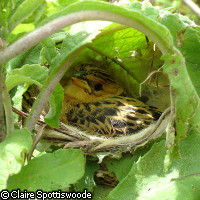Bird's-eye view of cuckoo in nest
Cuckoos are famous for two things: their evocative call and their habit of placing their eggs in another bird's nest, a practice that has always fascinated ecologists and ornithologists the world over. New research carried out by scientists at the University of Cambridge in the UK shows how a bird can tell if an egg in its nest is its own or an alien. The results, published this week in the Proceedings of the National Academy of Sciences (PNAS), offer insights into a 20-million-year-old evolutionary struggle. Most cuckoo species raise their own young, but the ones that don't are called brood parasites - birds that put their eggs in another bird's nest. Only seven groups of birds in the world have evolved in this way, including certain species of duck. Drs Claire Spottiswoode and Martin Stevens of the University of Cambridge carried out field experiments in Africa using practical tests and a new computer model that enabled them to take a closer look at the behaviour of parasitic cuckoos and their hosts. The researchers tested two tropical African species: the parasitic cuckoo finch and the tawny-flanked prinia, one of the cuckoo's hosts. For the most part, work on these species has been carried out in Europe and North America, where both species are relatively young in evolutionary terms. But in Africa the cuckoo finch and the prinia have been fighting it out for up to 20 million years. It seems that as the cuckoo finch's ability to infiltrate its eggs into the prinia's nest by matching them physically becomes ever smarter, so does the ability of the prinia to detect the imposters. Dr Spottiswoode said, 'Prinias lay probably the most diverse range of eggs of any bird in the world, and this is likely to be an outcome of the long co-evolutionary battle with the cuckoo finch. The eggs are analogous to a bank note in terms of the variety and complexity of markings, perhaps to make them very hard to forge by the parasite.' The scientists set up a series of 'rejection tests' in southern Zambia that involved putting foreign eggs into prinia nests to see if they would be rejected. They also collected detailed data on egg patterns and colour using a spectrophotometer, the results of which were then fed into a computer. A digital camera was also used to analyse the complexity of patterns and colours. Up to now, this kind of analysis was always carried out by eye but human vision differs greatly from that of birds. Birds have four types of cone in their eyes so they can see ultraviolet light, which allows them to better spot a greater diversity of colours and patterns than humans. The tests showed that prinias are extraordinarily good at rejecting alien eggs in their nests and they do this through minute differences in colour and pattern in the parasite eggs. Interestingly, the specific traits that the prinias use to reject the foreign eggs were exactly those that differed most between host eggs and real parasitic eggs. This implies that natural selection is currently making the cuckoo finch eggs better mimics of their hosts. The research was funded by the Royal Society, the Biotechnology and Biological Sciences Research Council (BBSRC) and the DST/NRF Centre of Excellence in South Africa.
Countries
United Kingdom



